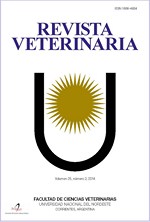Vinculación epidemiológica, bioestadística y ciencia de bienestar animal
DOI:
https://doi.org/10.30972/vet.3326186Palabras clave:
Bioestadística, Labor colaborativa, Epidemiología, MultidisciplinariedadResumen
Diferentes técnicas epidemiológicas y enfoques bioestadísticos se ubican en un contexto científico de bienestar animal, en una diversidad de especies y entornos, con referencia a una variedad de estudios proporcionados como ejemplos de referencia. La epidemiología es especialmente importante en la ciencia del bienestar animal, ya que permite el uso de entornos complejos fuera del contexto de laboratorio utilizando modelos que tienen en cuenta factores aleatorios. También es importante en la introducción de técnicas estandarizadas que permitan la síntesis de evidencia.Descargas
Citas
Lau B et al. 2020. Perspectives on the future of epidemiology: a framework for training. Am J Epidemiol 189: 634–639.
Mata F. 2013. Mastitis vaccination in dairy cattle: a meta-analysis of case-control trials. Revista Portuguesa de Ciências Veterinárias 108: 17-22.
Mata F. 2014. Analysis of predisposition factors for limb amputation in dogs with survival analysis in those diagnosed with appendicular cancer. Veterinary Nurse 5: 406-411.
Mata F. 2014. Evaluation of horse fitness for exercise: the use of a logit-log function to model horse post-exercise heart rate recovery. J Equine Vet Sci 34: 1055-1058.
Mata F. 2015. The interactive effects of diet, age and teeth in the oral health of cats. Anim 5: 101-107.
Mata F. 2021. A framework for using epidemiology in animal welfare science. J Appl Anim Welf Sci (epub ahead of print).
Mata F, Johnson C, Bishop C. 2015. A crosssectional epidemiological study of incidence of bit injuries in polo and race horses. J Appl Anim Welf Sci 18: 259-268.
Mata F, Lam A. 2013. Investigating the relationship between feed and helminthic burden of captive birds of prey in Hong Kong. Zoo Biol 32: 652-654.
Mata F, Mwakifuna B. 2012. Comparative mortality and predation in relation to egg production traits of Rhode Island Red, Black Australorp and Hyblack laying hens in scavenging production systems of rural Malawi. Brit Poultry Sci 53: 570-575.
Mata F, Williams J, Marks F. 2012. Investigation of factors associated with the probability of racehorses being pulled up in steeplechase races
at Cheltenham racetrack. Comp Exercise Physiol 8: 95-101.
Scarazzati S, Wang L. 2019. The effect of collaborations on scientific research output: the case of nano-science in Chinese regions. Scientometrics 121: 839-868.
Willeberg P. 1997. Epidemiology and animal welfare. Proceedings of the 8th International Symposium on Veterinary Epidemiology and Economics. Épidémiologie et Santé Animale, Paris, France.
Williams J, Parrot R, Damata F. 2012. The effect of manual and motorised dental rasping instruments on thoroughbred heart rate and behaviour. J Vet Behav 7: 149-156.
Descargas
Publicado
Cómo citar
Número
Sección
Licencia
Política de acceso abierto
Esta revista proporciona un acceso abierto inmediato a su contenido, basado en el principio de que ofrecer al público un acceso libre a las investigaciones ayuda a un mayor intercambio global de conocimiento. La publicación por parte de terceros será autorizada por Revista Veterinaria toda vez que se la reconozca debidamente y en forma explícita como lugar de publicación del original.
Esta obra está bajo una licencia de Creative Commons Reconocimiento-NoComercial 4.0 Internacional (CC BY-NC 4.0)










.jpg)
.jpg)



